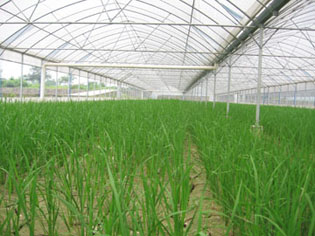August 14, 2007
 “Green”
super rice is one goal of the newly formed Shennong
Center for Crop Functional Genomics, a collaboration
between The
University of Arizona (UA) and
Huazhong
Agricultural University (HZAU) in Wuhan, China.
Green refers not to the color, but the fact that the
rice will be grown under very environmentally
friendly conditions.
“Green”
super rice is one goal of the newly formed Shennong
Center for Crop Functional Genomics, a collaboration
between The
University of Arizona (UA) and
Huazhong
Agricultural University (HZAU) in Wuhan, China.
Green refers not to the color, but the fact that the
rice will be grown under very environmentally
friendly conditions.
UA Department of Plant Sciences professor and
BIO5 member Rod
Wing, PhD, is working together on the rice project
with Qifa Zhang, PhD, who heads HZUA’s National Key
Laboratory for Crop Improvement – the number one
crop molecular biology lab in China.
“Rice feeds half the world and that half will double
in the next quarter century,” says Dr. Wing.
“Countries that depend on rice need to double the
yield on less land, less water and in poorer soils.
The green super rice will do that with less
fertilizers and pesticides, which is great for the
environment.”
Dr. Wing has significantly contributed to the
sequencing of one species of domesticated rice. This
understanding of domesticated rice, combined with
the knowledge gained from his most recent work
studying the genomes of wild relatives of rice will
ultimately lead to crop improvements.
The wild relatives of rice can grow in conditions
unsuited to domestic rice. Pinning down genes linked
to desirable properties such as crop yield, drought
tolerance, and resistance to pests, heat, cold,
weeds, salt and pathogens could make it possible to
grow domesticated rice in less than ideal
environments, thus increasing production acreage and
helping to reduce hunger around the world.
While Dr. Wing’s laboratory is studying the genome
organization and evolution of 14 wild relatives of
rice, Dr. Zhang’s laboratory has developed genetic
populations with three of the same wild relatives
that can be analyzed for yield, drought and pathogen
resistance. Once a beneficial trait is identified in
these populations, it can be isolated and studied.
Together,
the Shennong Center researchers will utilize
this system to develop green super rice varieties.
Additionally, it also will be used by the
international community to help identify the
function of all 30,000 genes in rice.
“Long-time relationships between the UA Plant
Sciences Department and Huazhong Agricultural
University are resulting in complementary talents
and systems coming together in ways that will
benefit many people,” says Dr. Wing.
Other projects are in development between HZAU, UA’s
BIO5 Institute, and the following UA departments:
Plant Sciences, Biochemistry and Molecular
Biophysics, Molecular and Cellular Biology and
Ecology and Evolutionary Biology.
For example, BIO5 Director and plant scientist Vicki
Chandler, PhD, is working together with HZAU on
finding ways to prevent a major fungal disease in
corn plants, a particular concern for farmers and
plant breeders in China. They also are interested in
how to make corn plants more tolerant to submergence
in water, which could translate to a large increase
in yield in the regions of southern China where
flooding is a serious threat.
The Shennong Center for Crop Functional Genomics was
formally initiated in Wuhun, China in May 2007. Drs.
Wing and Chandler traveled to Wuhun with UA plant
scientists and BIO5 members David Gang, PhD, David
Galbraith, PhD, Mark Orbach, PhD, and and Ravi
Palanivelu, PhD. BIO5 member Elizabeth Vierling,
PhD, UA Departments of Biochemistry and Molecular
Biophysics and Molecular and Cellular Biology also
attended, as did UA plant scientist Zhongguo Xiong
and postdoctoral research associate Jeremy Edwards
of Dr. Galbraith’s lab.
Collaboration goals include not only collaborative
research, but also workshops, trainings and faculty
and student exchanges. Letters of invitation have
been sent for several faculty and students from HZAU
to visit UA, and visa applications are underway.
Other news
from Huazhong
Agricultural University
RELATED NEWS PIECE: Strategies for developing Green Super Rice